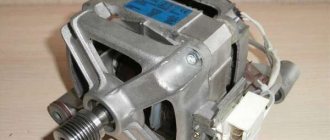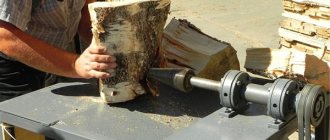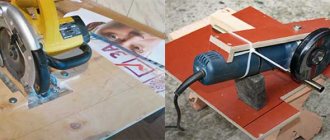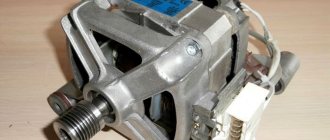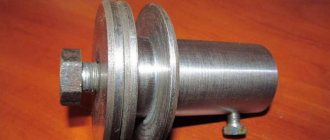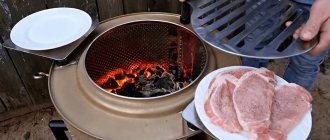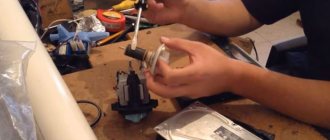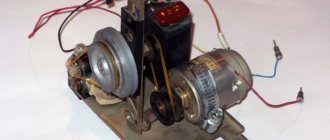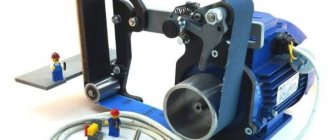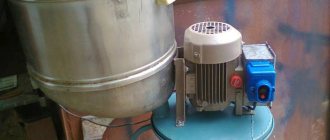Electricity is an expensive resource, and its environmental safety is questionable, because... Hydrocarbons are used to generate electricity. This depletes the mineral resources and poisons the environment. It turns out that you can power your home with wind energy. Agree, it would be nice to have a backup source of electricity, especially in areas where there are frequent power outages.
Conversion units are too expensive, but with some effort they can be assembled yourself. Let's try to figure out how to assemble a wind generator with your own hands from a washing machine.
Next, we will tell you what materials and tools you will need for the job. In the article you will find diagrams of a wind generator from a washing machine, expert advice on assembly and operation, as well as videos that clearly demonstrate the assembly of the device.
We construct a generator from a washing machine engine
A generator is an electrical device that converts thermal or mechanical energy into electric current, that is, it performs the normal operation of an electric motor in reverse order. The purpose of creating a generator from an asynchronous motor of a washing machine (any other motor from a household appliance of suitable power) can be to create:
- inverter type welding machine;
- uninterruptible power supply for a private home (apartment);
- charger and so on.
How to make a generator?
But in order to better understand how to make a generator from a washing machine engine, let’s figure out what an asynchronous motor from an unnecessary washing machine is.
Design and features of using a windmill
Wind generators are rarely used as the main sources of electricity, but they are ideal as additional or alternative ones.
This is a good solution for dachas and private houses located in areas where there are often problems with electricity.
Assembling a windmill from old household appliances and scrap metal is a real action to protect the planet. Garbage is as pressing an environmental problem as environmental pollution from hydrocarbon combustion products
A homemade wind generator made from a screwdriver, a car generator or a washing machine engine will cost literally pennies, but it will help you save a decent amount on energy bills.
This is a good option for thrifty owners who do not want to overpay and are willing to make some efforts to reduce costs.
Car generators are often used to make windmills with their own hands. They don’t look as attractive as industrially produced structures, but they are quite functional and cover part of the electricity needs
A standard wind generator consists of several mechanical devices, the function of which is to convert wind kinetic energy into mechanical, and then into electrical. We recommend looking at the article about the design of a wind generator and its operating principle.
Most modern models are equipped with three blades to increase efficiency and begin to work when the wind speed reaches at least 2-3 m/s.
Wind speed is a fundamentally important indicator on which the power of the installation directly depends.
The technical documentation for industrial wind generators always indicates the nominal wind speed parameters at which the installation operates with maximum efficiency. Most often this figure is 9-10 m/s.
The main advantages of wind as an energy source are renewability and inexhaustibility. People have long been inventing various devices that allow them to rationally use the power of the elements, and a wind generator is one of the successful attempts to curb the wind
There are also parameters for the maximum permissible wind speed - 25 m/s. With such indicators, the efficiency of the wind turbine is already significantly reduced, because the blades of the installation change position. If we are talking about a homemade design, it is difficult to determine its technical characteristics.
It makes sense to focus on average indicators and calculate the amount of energy required for basic needs.
If you need to make a homemade 220V windmill, we recommend that you read the detailed assembly instructions.
How to choose and convert a washing machine engine into a generator
How to make a generator from an electric motor with your own hands? Not easy. You will need patience, as well as the ability to make some parts on a lathe.
From a conventional asynchronous motor of an automatic washing machine with a power of 170-180 W, it is possible to create a generator with a power of 1.5 kW. It is better to use the engine from the Vyatka washing machine and other Soviet-made models, since they are more powerful.
Tools and Parts
Also for work you will need:
- neodymium magnets of 20, 10 and 5 mm sizes – 32 pieces in total;
- rectifier;
- glue;
- lathe;
- sandpaper;
- cold welding;
- scissors;
- pliers, screwdrivers.
Work order
Magnets can be purchased either in specialized stores or on the Internet. If you don’t have a lathe at home, you can order the production of parts from a familiar craftsman.
- It is necessary to remake the rotor of an asynchronous motor so that magnets can be installed. To do this, the cores are removed, part of them is cut on a lathe to a depth of 2 mm.
- To install magnets, you need to make grooves in the core to a depth of 5 mm.
Core preparation is complete. Now you need to put the magnets in place. To do this, make a covering for the core from a piece of tin. This template must exactly match the located holes. Therefore, cut a piece exactly according to the diameter of the core, with holes in the right places.
Note! The magnets must be installed at equal distances from each other. Otherwise, during operation they will begin to stick together, causing the electric generator to lose power.
Installation of magnets and step-by-step assembly of the generator
Let's look at how to convert an engine into a homemade generator.
- Place the magnets on a strip of glued tin - at an equal distance. The magnets are also attached with superglue. It is important that they are all located level, without tilting. Since the magnets are strong and may come off during operation, wear safety glasses.
- Once the magnet template is positioned on the rotor, fill any gaps between them with cold welding. To do this, knead the mixture well and cover the entire space. You can also fill the space between the magnets with epoxy resin.
- Using sandpaper, sand the rotor surface until completely smooth. For convenience, you can clamp it in a vice.
- Check the housing bolts and bearing, they may need to be replaced with new ones.
The remodeling work is completed. You have made a generator from a direct drive motor. You can start checking your homemade device.
Comparing the pros and cons of installation
Wind generators have been used for many years, their designs are constantly being improved, and wind is an easily accessible source of energy.
Devices powered by it are absolutely safe for the environment and convenient, because... are located on masts and do not occupy useful space. They are easy to maintain and repair.
Due to the instability of wind generators, it is necessary to invent ways to provide homes with additional energy. A good option is a combination of wind and solar installations
Windmills make noise when operating. The sound may be louder or quieter, but it is always there. Sometimes this bothers home owners and even neighbors.
There are other inconveniences that can be noted. Wind is an unpredictable element, so the operation of generators is unstable and it is necessary to accumulate energy so as not to be left without electricity during periods of calm.
Advantages of a homemade wind generator
The main advantage that determines the choice of most users is the difference in cost between a factory kit and a homemade windmill. For sets of equal power and performance, it can be 10- and even 20-fold. If a relatively inexpensive Chinese wind generator costs 75,000 rubles , then a homemade wind turbine will require about 3,500, or a little more. The difference is so significant that you don’t have to think long about the choice.
In addition, homemade devices have a number of significant advantages that are not noticeable at first glance, but greatly facilitate operation and increase the service life of the installation:
- high maintainability. For a person who has made a complex device with his own hands, there can be no problems with repairs, adjustments or any design changes
- possibility of changing operating parameters. Does the created device not meet the needs of users? The reasons for this are quite clear to the manufacturer, who can always change the characteristics of the installation by adding the necessary elements or parts
- The service life of homemade installations is almost unlimited. Any node that has exhausted its resource is replaced with a more recent or powerful one as needed. An installation that undergoes constant modernization and updating will, in any case, last as long as its owner needs.
Arguments are often heard about the large investment of time and unpredictable results of making a windmill with your own hands. Time is running out, that's for sure. It is also impossible to completely predict the result, since completely unknown quantities must be taken into account, and no one is yet able to predict the behavior of air flows. But most of these questions are open for a purchased wind generator, and if its power is selected with errors, then the money will be wasted, which does not happen with homemade kits.
Types of wind generators and their operating principles
Both industrial and homemade wind generators are different.
They are classified according to several criteria:
- Features of rotation of the rotor with blades attached to it - vertical or horizontal. The former react less to negative environmental factors, while the latter are characterized by higher efficiency.
- Number of blades. Three-blade installations are considered the most practical, but there may be more or fewer blades.
- Material . For the manufacture of blades, various materials are used - hard or sailing. The former are usually more durable, while the latter are cheaper.
- Blade pitch . It can be fixed or changeable.
When making a wind generator with your own hands, you have to decide on the design yourself. In this case, it is necessary to calculate the required power and take into account the operating conditions of the installation. We discussed the detailed calculation of a wind generator using formulas in this article.
The easiest way to make a horizontal wind generator. People without much experience choose just such a design, but some craftsmen prefer to put effort into making a low-noise and efficient vertical installation
Horizontal windmills are convenient because their creation does not require high-precision calculations; the design itself is easier to manufacture and starts at the slightest wind. Cons: loud noise during operation and bulkiness.
A vertical wind generator is suitable for people who are willing to spend time and effort on assembling and maintaining a complex but compact design. We recommend watching the step-by-step instructions for making a vertical wind generator with your own hands.
The converting devices of the wind generator transform the electric current, which leads to large energy losses. Depending on the characteristics of the devices, these losses can reach 15-20%
A wind generator operates by rotating blades attached to a rotor. The rotor itself is fixed on the generator shaft, which generates electric current. The energy is transferred to batteries. Here it accumulates and powers household electrical appliances.
The wind turbine is equipped with a controller that converts three-phase alternating current into direct current and controls battery charging. The installation diagram must take into account that an inverter must be connected after the battery.
Testing a homemade device
The process of making a generator from a washing machine engine is completed, all that remains is to test it in action. To perform the check you will need:
- rectifier;
- multimeter;
- charging controller;
- motorcycle battery;
- homemade electric generator.
Think about how the rotation will take place. You won’t be able to do this with your fingers, as you won’t be able to create the required number of revolutions. We recommend using an electric drill or screwdriver.
We identify a couple of working wires on the prepared device, and cut off the rest. We connect the wires through a rectifier to the charging controller, and then to the battery. We fix the multimeter mounts to the battery terminals - the generator is ready for testing.
We charge the generator pulley into the chuck of the power tool, with the help of which the spin will be performed, and give the speed within 800 - 1000 rotations. As a result, with moderate sticking of the magnets, you should get 270 Volts, which will be a completely acceptable indicator.
How to check the generator
What you will need to check:
Using a multimeter, find the two wires leading to the working winding; they should show the same resistance. We cut off the remaining wires as unnecessary.
Now connect the wires of the working winding to the rectifier. The latter is connected to the controller, which in turn is connected to the battery. To check how much power the generator produces, connect the leads of a multimeter (set in voltmeter mode) to the battery.
Using a drill or screwdriver, spin the electric generator at a speed of 800-1000 rpm. If the multimeter shows from 200 to 300 Volts, this is an excellent result. If the voltage is low, the magnets are most likely not installed evenly.
Connecting the washing machine motor
To connect the motor to alternating current, perform the following steps:
1
.
First you need to prepare a tester - this is a special device used to determine the winding wires. 2
.
To determine a pair of wires, connect the tester probe to any wire and check all the others one by one. If during connection the tester indicated a connection, then this will be a pair of wires. Accordingly, the other two wires will also form a pair. 3
.
We measure the resistance level of two windings. The winding with a higher value is the starting winding. 4
.
Wires from different windings are connected in pairs, then connected to a 220 V network 5
. It is recommended to install the switch on the starting winding wire.
In some cases, the direction in which the motor rotates must be changed. Here we swap the leads of the starting winding.
Possible applications
So, I managed to create a generator with my own hands. The savings in this case, according to the most conservative estimates, will be more than 4,000 rubles. After all, in the retail chain it costs from 6,000, and you will only spend money on purchasing magnets (1,200–1,400 rubles). The scope of use of the unit, which provides up to 2 kilowatts of power, depends on your imagination and desire. You can illuminate a country house by connecting it to the motor of a motorcycle or chainsaw.
Connect to a windmill or hydraulic turbine, creating a waterfall or fast stream on your site yourself. The benefit is undeniable!
Source
Motor from an old washing machine for a lathe
Assembling a lathe yourself is not a difficult task. All you need to do is fix the adapter on the base of the motor shaft from an old washing machine. The adapter should not be permanently secured. It is better if it is removable, since this way the lathe will become multifunctional, with the ability to turn parts, sharpen knives with a sharpening wheel, cut metal and plastic pipes with a cutting wheel, and use other attachments. The photo shows possible attachments.
You should not fix this homemade product on a solid base. To make work more convenient, it is recommended to make it portable. The basis will be a thick, durable board. To secure the resulting lathe, it is recommended to use brackets that are screwed onto the base using bolts from the washing machine. A regular switch can be used, or from a washing machine.
Assembly diagram
Of course, the electric motor was gone, but along with it, there was no timidity in front of the unknown, because now there was no unknown either. In the photo, the conductors form windings and end with leads. The connections of the windings are different, but the electrical essence does not undergo major changes. The relatively thick wires of the stator windings suggested that a good current could be obtained from this engine, even if it were used as a generator, and even if it produces a few volts of voltage, then “happiness” is possible!
Grain crusher from a washing machine
With this useful homemade product, you can significantly save on the preparation of feed for domestic animals. If you choose an engine of sufficient power, it is quite possible to assemble a feed cutter, grain crusher and grass cutter, which will not be inferior in performance to factory models. In this case, it is recommended to use an engine from an automatic washing machine - they are distinguished by higher power.
It doesn't take a lot of work to turn an old washing machine into a feed cutter. You need to take an engine from an automatic machine and a body from another old washing machine - with a top load. It’s quite easy to find such a case; it costs pennies at a scrap metal collection point.
Step-by-step description of creating a feed cutter with your own hands:
1
.
The blades with knives should have a diameter such that they do not reach quite a bit to the edges of the body. 2
.
We make a hole in the bottom to remove the finished food. 3
.
We install one blade with knives in the lower part of the body, the other - 40–50 cm from the upper edge; To ensure better grinding quality, you need to use 2 different shafts for the knives, they should rotate in different directions. 4
.
We screw the motor onto the lid of the washing machine and attach it to the shafts. 5
.
We cut a hole in the lid to fill in the raw materials. 6
. We install the cover in place and test the homemade product in action.
Installation of supporting structure and blades
When building a vertical windmill for a home with your own hands, special attention is paid to the base of the entire structure, since the unit itself should be raised as high as possible above the ground. This will require more serious financial investments, but the energy saved will pay for these costs over time.
The higher the structure, the higher the wind speed, therefore, for a device with large dimensions and weight, preparation of the foundation is required.
This installation requires thorough strengthening and a reliable foundation.
The blades of any type of device should be mounted at a certain angle, both for vertical and horizontal devices.
The location of the blades on a horizontal unit
Drawing of the direction of the blades of the vertical device
The blades of a small device made of plastic. It’s obvious that you made it with your own hands.
Important! In stormy winds, the operation of wind turbines is not recommended, as the blades may not withstand heavy loads. Provide a means of emergency rotor stop in your design.
Emery from a washing machine motor
An emery machine is useful for almost any household.
It can be made in a simple way - for this it is enough to prepare the engine from an automatic washing machine in working condition. When you attach the sharpening stone to the motor, some difficulties may arise - the hole of the stone may not coincide with the diameter of the electric motor shaft.
In this case, you need to take an additional part that will need to be specially machined. This adapter can be easily made by any turner; you just need to tell him the diameter of the shaft.
In addition to the adapter, you need to have a special bolt, nut, and washer.
The thread on the nut should be cut depending on which direction the motor will rotate.
In order for the motor to rotate clockwise, the thread must be left-handed; for counterclockwise rotation, the thread must be right-handed.
If you do the opposite, the stone will constantly unwind and fly off during work.
It may be that you have a nut, but the thread direction is not correct. Then we change the direction of rotation. In this case, we swap the winding wires.
We connect the working winding to a 200 V network, connect the starting pair to the working coil.
We apply the second end to the winding terminal for a short time. The commutator electric motor will begin to move in one direction.
When the locations of the starting winding terminals change, the direction of movement of the motor will change to the opposite.
The direction of rotation of the motor can be changed without using a capacitor. Here, after connecting the working winding to 220 V, we sharply turn the stone in the right direction.
After this, the motor starts and the machine starts working.
Testing
The current generated by a generator made from a brushed motor is supplied to the battery. It is connected to the charge controller and module. By using an inverter, the DC voltage from the grid is converted into AC voltage to power household appliances. To find out if your product provides the required 220 volts and 50 hertz, you need to conduct a test.
You need:
- battery;
- rectifier;
- controller;
- tester.
Using an ampere-voltmeter, test the terminals of the motor winding and find the two that are active after the alteration. Cut off the old ones.
Connect the found contacts to the controller via a rectifier. And the last one is with the battery terminals.
Connect the drill to the rotor with an adapter and turn it on at 1000 rpm. Measure the voltage at the battery input with a tester. If everything is done and assembled correctly, it will be the desired one - 220 Volts.
Important! Observe the winding for sticking. If it is high, the generator power will be low.
Lawn mower made from a washing machine motor
A lawn mower is another example of how you can intelligently use a motor from a washing machine. This unit will be very useful if you have a summer cottage or garden plot. To make a lawn mower, you don't need many parts; all the materials can be found among household supplies in the garage or workshop.
Stages of work
Preparing the template
So, the core is ready, now you can move on to processes that fall into the “do-it-yourself” category. To attach the magnets to the core of the washer, you need some kind of device. It can be made from a tin strip or from another material with similar technical characteristics.
The length and width of the sheet metal strip is adjusted to the dimensions of the core diameter and the width of the grooves. That is, the template must fit exactly where the magnets are installed
Pay special attention to the fact that the distance between the magnets must be the same
Generator assembly
Everything is ready, you can proceed to assembling the electric motor-generator with your own hands. Let's say right away that this process requires special patience. There's no need to rush here. The thing is that the magnets will be installed in the grooves of the electric motor core using glue. Their small size creates difficulty and inconvenience in installation; the glue slips, its splashes will get on your hands, sometimes even on your face. So you shouldn’t neglect labor safety measures. After all, the adhesive composition is a chemical solution, quite active.
So, here is an assembly diagram on how to make a generator with your own hands:
a prepared tin template is glued across the rotor; then neodymium magnets are installed in the prepared grooves, here it is very important, as mentioned above, to accurately observe the installation distance and the angle of inclination of the elements, because even a slight deviation from these two parameters can cause sticking, which will certainly lead to a decrease in the power of the homemade generator; now the gap between the magnets must be filled with a special material called cold welding, it is very similar to plasticine; and the last stage is grinding the surface with sandpaper, this can be done by placing the rotor in a vice, or on the floor or table; The entire electric motor is assembled with your own hands.
Generator testing
To check how the generator we assembled works, you need several additional elements. Namely:
- small capacity battery, maybe from a motorcycle;
- rectifier;
- multimeter to determine charging power;
- charge controller.
The generator connection diagram for testing is as follows: two generator windings are connected through a rectifier to a charge controller.
The latter is connected to the battery. The multimeter is also connected to the battery terminals. The most difficult thing to check is turning the electric motor rotor. It will not be possible to achieve the required rotation speed manually. Therefore, it is recommended to use either a drill or a screwdriver for these purposes. You connect one of these tools to the engine rotor (there are different options, and there are many of them) and start turning it at a rotation speed of 800-1000 rpm. If the generator you made produces a voltage of 220-300 volts, then this is an excellent indicator. If the voltage is very low, it means that the rotor was assembled poorly. This mainly concerns the installation of magnets (uneven installation and not all elements are attached at the same angle).
Where to use
We managed to make a generator from a washing machine's electric motor. Testing has shown that it works. So, what is next? Where can this unit be used?
In principle, if you find energy that could rotate the rotor, then there would be no problems with electricity, for example, in a small country house. Therefore, home craftsmen offer several commonly used options:
- Install the generator to the gasoline engine. For example, it could be an old Druzhba saw or a motorcycle engine.
- Connect to a windmill, thereby making a wind current generator.
- Connect to a hydraulic turbine, which is installed in a homemade waterfall or fast-flowing stream.
The last two options are the cheapest, since there is no need to buy additional energy.
These are environmentally friendly installations running on alternative fuels. And one moment. Making a 5 kW generator out of a washing machine motor will no longer work. Therefore, do not rely on the fact that from this unit you can make a device that completely replaces the electrical network. But for a couple of rooms or for a bathhouse (garage, etc.) it will be suitable. The maximum that such a generator can produce is 2 kW. Besides, don’t expect 380 volts from it either.
Let us add that a generator can also be made from a DC motor. Moreover, in some washing machines, such units are installed. In such motors, graphite brushes are a distinctive feature.
DIY vibration table
Using the motor from a washing machine, we can make a vibrating table for paving slabs.
Equipment of this type is constructed in a fairly simple way. A homemade vibrating table is made in the form of a plate, which is the upper part of the device, attached to a metal base using a movable connection, with a motor with an eccentric from a washing machine. When the slab vibrates, air bubbles come out of the concrete that is poured into the molds on this slab and voids disappear. Thanks to this, the finished products are characterized by high strength and quality.
Use of wind power generators at home
Based on the above factors, the question arises: why not install a windmill in every house? The answer consists of two main points:
- Price. The cost of devices with sufficient power is very high. For example, the cost of a unit with a power of 2 kW and a voltage of 24 V ranges from 75,000 rubles;
- The average wind force in most regions does not reach 4 m/s.
Map of average annual wind speed in Russia
That is, the use of wind turbines as the main source of energy is irrational. In a standard house, with the simultaneous operation of all household appliances, up to 1 kW per hour is consumed, and when operating powerful power tools, this figure increases, increasing the required voltage in the network.
To ensure uninterrupted power supply, you will need at least: a combination of three wind turbines of 3 kW, or one with a capacity of at least 10 kW; several batteries of sufficient capacity; reliable controller and inverter.
Installation of the entire system will cost at least 400,000 rubles, and with variable wind speeds, this method of power supply loses its relevance.
A clear example of a circuit with a high power device
It is advisable to use self-assembled 220-volt windmills as an alternative source of energy. In combination with solar panels, a fuel generator of sufficient power or a central power grid.
Important! If there is a combination of sources, it is necessary to include in the ATS system (automatic switching on of backup power). This device controls the supply of energy by changing the power source
Diagram of a wind turbine and city power supply
Electrical system using three sources
Video - working under load
I will take the liberty of declaring that even this particular engine can be used as a wind generator capable of generating sufficient electric current to charge one AAA battery with a voltage of 1.2 V and a capacity of up to 1000 mA inclusive. Please pay attention to the photo that shows the installation of gears on the base. The right side of the large gear is just begging to be installed with another motor. The kinematic diagram will be as follows: one drive wheel rotates two driven ones. The possibilities are doubled, it becomes possible to assemble a boost converter and even charge mobile phone batteries. Babay dealt with electricity production issues .
Discuss the article GENERATOR FROM AN ENGINE WITH YOUR OWN HANDS
Photos and diagram of a stable beetle on one transistor. Homemade swing gates for a private house - electronics and mechanics. Electrical diagram and photo of the installation process.
Electricity is an expensive resource, and its environmental safety is questionable, because... Hydrocarbons are used to generate electricity. This depletes the mineral resources and poisons the environment. It turns out that you can power your home with wind energy. Agree, it would be nice to have a backup source of electricity, especially in areas where there are frequent power outages.
Conversion units are too expensive, but with some effort they can be assembled yourself. Let's try to figure out how to assemble a wind generator with your own hands from a washing machine.
Next, we will tell you what materials and tools you will need for the job. In the article you will find diagrams of a wind generator from a washing machine, expert advice on assembly and operation, as well as videos that clearly demonstrate the assembly of the device.
